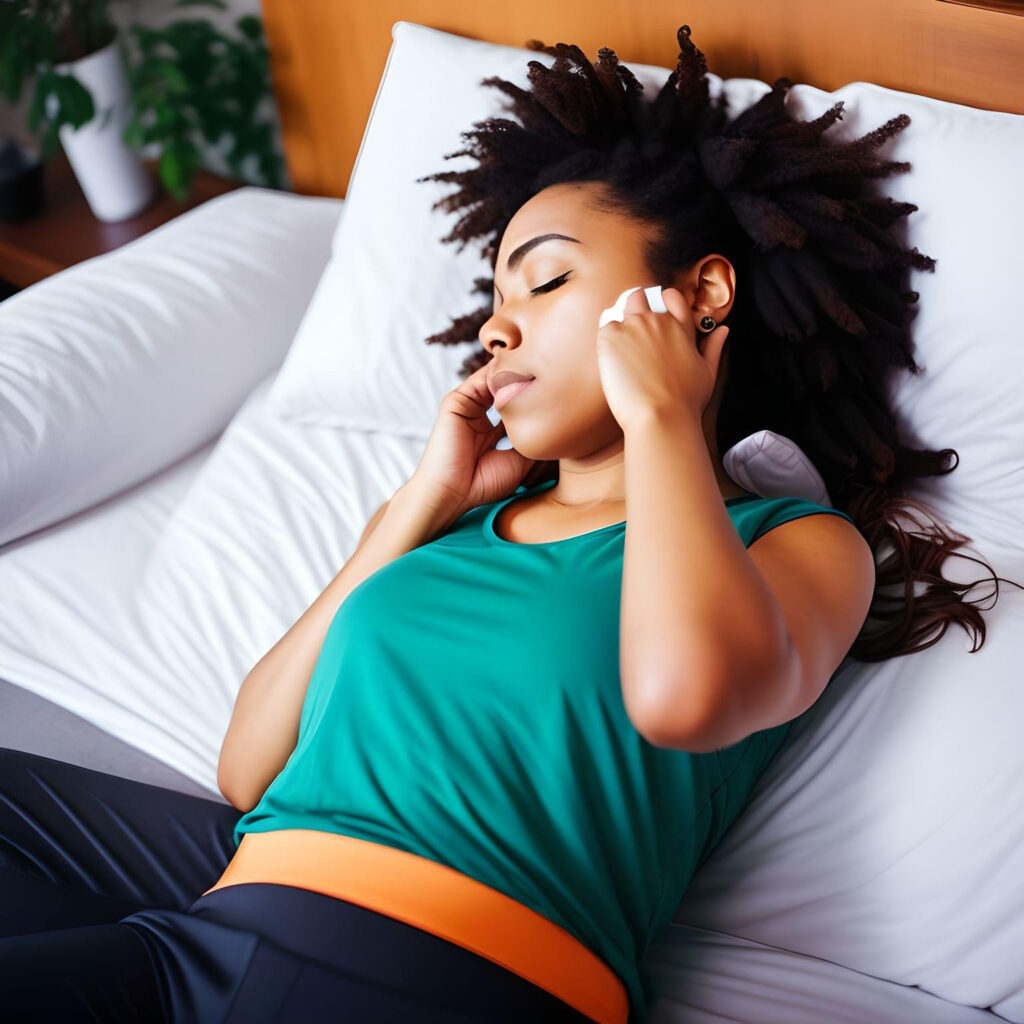*This post may contain affiliate links for which I earn commissions.*
While lucid dreaming can be a fascinating and enjoyable experience, it can also be elusive for some people. You may have heard that sleeping position can have an impact on lucid dreaming, but is this the case? So does sleeping position matter for lucid dreaming?
Read on to find out the real story.

Experts are split on the issue of whether or not sleeping position can impact lucid dreaming. Some believe that certain positions may make it easier to achieve lucid dreaming, while others think that it may have little to no effect. However, it is worth exploring the topic further to see if there is any merit to the idea.
Key Takeaways:
- Lucid dreaming is when you become aware that you are dreaming and can actively participate in the dream world.
- There is debate among experts as to whether sleeping position can impact lucid dreaming.
- We will explore the connection between sleep position and lucid dreaming as well as offer tips and techniques to potentially enhance your chances of experiencing lucid dreams.
Understanding Lucid Dreaming
Have you ever experienced a dream where you were aware that you were dreaming? This is known as lucid dreaming, a unique state of consciousness that occurs during REM (rapid eye movement) sleep. During lucid dreaming, you can actively participate in and control the events of your dreams, allowing you to explore and experience your subconscious in a whole new way.
Lucid dreaming can offer many benefits, such as improving creativity, reducing anxiety, and even helping with problem-solving. However, achieving lucid dreams can be challenging and requires consistent practice and dedication.
While the exact mechanisms behind lucid dreaming are still being studied, it is believed that certain factors, such as sleep position, can potentially influence the occurrence of lucid dreams. By understanding how lucid dreaming works and the potential impact of sleep position, you can enhance your chances of experiencing this fascinating state of consciousness.
The Connection Between Sleep Position and Lucid Dreaming
Lucid dreaming, as explained earlier, refers to the state of being aware that you’re dreaming and having some level of control over the dream. While the concept of lucid dreaming is fascinating, it remains mysterious to many. And one of the factors that could potentially influence the occurrence of lucid dreams is sleep position.
There is some anecdotal evidence to suggest that certain sleeping positions may be more conducive to lucid dreaming than others. However, scientific research on this topic is limited and inconclusive. One theory is that certain sleep positions can help improve circulation to the brain, which may increase the likelihood of experiencing lucid dreams.
It’s worth noting that sleeping position is just one factor that can affect lucid dreaming. Other factors such as sleep quality, dream journaling, reality checks and mindfulness practices can also play a role. Therefore, it’s essential to consider a holistic approach to lucid dreaming.

Although the scientific evidence is not definitive, it’s still worth experimenting with different sleeping positions if you’re interested in lucid dreaming. Some individuals report having more lucid dreams when they sleep on their back, while others find that sleeping on their side or stomach works best for them. Experiencing lucid dreaming is a highly individual experience, so it’s worth trying out different positions and keeping a dream journal to track your progress.
Optimal Sleep Positions for Lucid Dreaming
There are several sleep positions that are believed to enhance the likelihood of experiencing lucid dreams. However, it is important to note that what works for one person may not necessarily work for another. The key is to experiment with different sleep positions and techniques to find what works best for you.
The most commonly recommended sleep position for lucid dreaming is sleeping on your back. This is because it allows your body to fully relax, which can enhance the onset of sleep paralysis, a common precursor to lucid dreaming. Try placing a pillow under your knees to alleviate any discomfort. It is also important to have a comfortable pillow to support your neck and head.

Another popular sleep position for lucid dreaming is sleeping on your side, specifically the right side. This position is believed to promote better blood flow to the brain, which can improve the quality of your dreams. Sleeping on your left side is also beneficial, as it can reduce the likelihood of experiencing nightmares.
Sleeping on your stomach is generally not recommended for lucid dreaming, as it can lead to discomfort and breathing difficulties. However, some people have reported success with this position, particularly when placing a pillow under their pelvis to alleviate any strain on their neck and back.
It is important to note that simply changing your sleep position may not guarantee lucid dreams. It is only one of several factors that can potentially influence the occurrence of lucid dreams. It is also important to create a conducive sleep environment, practice good sleep hygiene, and consider other techniques for enhancing the likelihood of lucid dreaming.
The Connection Between Sleep Position and Lucid Dreaming
There is some evidence to suggest that sleep position may impact the likelihood of experiencing lucid dreams. According to a study published in the journal Sleep and Hypnosis, participants who slept on their left side reported having more vivid and memorable dreams compared to those who slept on their right side or back. This could potentially be related to the fact that the left side of the brain, which is associated with creativity and imagination, is more active during REM sleep.
Another theory is that sleeping on your stomach may decrease the likelihood of experiencing lucid dreams, as it can restrict breathing and lead to a less restful sleep overall. However, these theories are largely speculative, and more research is needed to fully understand the connection between sleep position and lucid dreaming.
Despite the lack of conclusive evidence, many lucid dreamers swear by certain sleep positions that they claim enhance their ability to have lucid dreams. Some common recommendations include sleeping on your left side, sleeping with your head facing north, or sleeping with a pillow under your knees to alleviate pressure on your back and minimize discomfort.

Experiment with different sleep positions to see what works best for you. Keep a dream journal to track your experiences and look for patterns or correlations between your sleep position and the frequency of your lucid dreams.
Ultimately, the impact of sleep position on lucid dreaming is likely to vary from person to person. It’s important to prioritize overall sleep quality and experiment with different approaches to lucid dreaming to find what works best for you.
The Importance of Sleep Quality
While sleep position can potentially impact the occurrence of lucid dreams, it is important to also consider overall sleep quality. The duration and quality of your sleep can profoundly affect your cognitive function, emotional well-being, and physical health. Therefore, it is essential to establish good sleep hygiene habits and create a conducive sleep environment.
To improve sleep quality, make sure to create a comfortable and dark sleep environment, avoid stimulating activities before bed, and establish a consistent sleep schedule. Additionally, prioritize regular exercise and a healthy diet, as these factors can significantly improve sleep quality.
In combination with appropriate sleep position, adopting these habits and techniques can enhance your chances of experiencing lucid dreams. Remember that lucid dreaming is just one potential benefit of good sleep quality, and establishing healthy sleep habits can lead to a multitude of other benefits for your overall health and well-being.

The Connection Between Sleep Position and Lucid Dreaming
Lucid dreaming can be influenced by several factors, including sleep position. Research on the relationship between sleep position and lucid dreaming is limited, but anecdotal evidence suggests that certain positions may increase the likelihood of experiencing lucid dreams.
One theory suggests that sleeping on your back may increase the potential for lucid dreams. This position allows for optimal breathing and may promote relaxation, leading to a higher likelihood of experiencing lucid dreams. However, other sources suggest that sleeping on your side may be more effective as it reduces the likelihood of sleep disruptions and can improve overall sleep quality.
It is important to note that sleep position should be considered in the context of overall sleep hygiene. Poor sleep quality, including insufficient sleep duration, irregular sleep patterns, and inadequate sleep environment, can negatively impact the potential for experiencing lucid dreams. Therefore, in addition to experimenting with different sleep positions, it is important to prioritize creating a conducive sleep environment and incorporating healthy sleep habits.
Personal Experiences and Anecdotal Evidence
Many individuals who have experimented with sleep positions have reported increased lucid dreaming experiences. For example, some have found that sleeping on their back increases their chances of having a lucid dream, while others have found the opposite to be true.
One Redditor shared their experience, saying, “I’ve found the best position for me is sleeping on my side, but with my top leg pulled up towards my chest a bit. I don’t know why it works, but it just does!”
Another study found that individuals who slept on their left side reported more vivid and lifelike dreams compared to those who slept on their right side.
Of course, personal experiences and anecdotes should be taken with a grain of salt, as individual factors can vary greatly. What works for one person may not work for another. However, these accounts can provide insight and inspiration for those looking to experiment with different sleep positions for lucid dreaming.

The Importance of Expert Opinions and Recommendations
When it comes to the topic of sleep and dreaming, there are many experts who have studied the relationship between sleep position and lucid dreaming. Sleep experts and researchers can provide valuable insights into the science of sleep and dreaming, and offer recommendations for how to optimize your sleeping position for lucid dreaming.
For example, Dr. Stephen LaBerge, one of the foremost experts on lucid dreaming, suggests experimenting with different sleep positions to see which works best for you. He recommends sleeping on your back, as this position tends to be associated with more vivid and intense dreams. However, not everyone finds this position comfortable, so it’s important to find a position that works for you.
Other experts suggest that sleeping on your stomach or side may be more conducive to lucid dreaming, as these positions can help reduce sleep disturbances and promote deeper, more restful sleep. However, more research is needed to fully understand the relationship between sleep position and lucid dreaming.
Ultimately, the best sleep position for lucid dreaming will vary from person to person, and may depend on a variety of individual factors, such as sleep habits, body type, and personal preferences. It’s important to experiment with different sleep positions, techniques, and approaches to find what works best for you.

Remember that sleep position is just one of many factors that can influence the occurrence of lucid dreams. Other factors, such as dream journaling, reality checks, and mindfulness practices, can also play a role in enhancing your chances of having lucid dreams.
By taking a holistic approach to lucid dreaming, and incorporating a variety of techniques and strategies, you can increase your chances of experiencing the incredible world of lucid dreams.
Tips for Experimenting with Sleep Position for Lucid Dreaming
If you’re interested in exploring how sleep position can impact your lucid dreaming experiences, there are several techniques and tips that you can try. Here are some ideas:
- Experiment with different sleep positions: Start by trying out different sleep positions to see which one works best for you. Some people find that sleeping on their back or in the “lotus” position (cross-legged) increases their chances of having lucid dreams, while others prefer sleeping on their side or stomach. Keep track of your experiences in a dream journal to see if there are any patterns.
- Adjust your pillow: The height and firmness of your pillow can also impact your sleep position and potentially your lucid dreaming experiences. Try experimenting with different pillow types and positions to find the one that works best for you.
- Add props: Some people find that adding certain props, such as a body pillow or a rolled-up towel under their knees, can promote a more comfortable and conducive sleep position for lucid dreaming.
- Practice relaxation techniques: Before going to bed, practice relaxation techniques such as deep breathing or meditation to promote a more restful and peaceful sleep. This may increase your chances of having lucid dreams, regardless of your sleep position.
- Stick to a sleep schedule: Establishing a regular sleep schedule and sticking to it can also improve the quality of your sleep, potentially enhancing your likelihood of having lucid dreams.
Remember, experimenting with sleep positions for lucid dreaming is a personal journey and what works for one person may not work for another. Be patient with yourself and enjoy the process of discovering what helps you achieve your lucid dreaming goals.

Conclusion
As we’ve explored throughout this article, the relationship between sleep position and lucid dreaming is complex. While there is some evidence suggesting that certain sleep positions may enhance the chances of experiencing lucid dreams, it’s important to remember that sleep position is just one of many factors that can influence the occurrence of lucid dreaming.
To increase your chances of having lucid dreams, it’s important to take a holistic approach that includes factors such as overall sleep quality, dream journaling, reality checks, and mindfulness practices. By experimenting with different sleep positions and techniques, you can further optimize your chances of experiencing lucid dreams.
Remember to keep track of your experiences in a dream journal and don’t get discouraged if you don’t experience lucid dreams right away. Like any skill, the ability to have lucid dreams takes time and practice to develop. With patience and a commitment to exploring different techniques and approaches, you can enhance your dream life and unlock the incredible potential of lucid dreaming.
FAQ
Q: Does Sleeping Position Matter For Lucid Dreaming?
A: Yes, your sleeping position can potentially impact your ability to have lucid dreams.
Q: What is lucid dreaming?
A: Lucid dreaming is when you become aware that you are dreaming while still in the dream state.
Q: Is there a connection between sleep position and lucid dreaming?
A: There is some evidence to suggest that sleep position may influence the likelihood of experiencing lucid dreams.
Q: What are the optimal sleep positions for lucid dreaming?
A: Different sleep positions may have varying effects on lucid dreaming. Some individuals have reported success with sleeping on their back or on their side.
Q: Are there any techniques to improve sleep position for lucid dreaming?
A: Yes, there are certain exercises, stretches, and adjustments that can be done to promote better sleep posture and potentially increase the chances of having lucid dreams.
Q: How does sleep quality affect lucid dreaming?
A: Sleep quality plays an important role in lucid dreaming. Factors such as sleep duration, sleep hygiene, and creating a conducive sleep environment can enhance the potential for experiencing lucid dreams.
Q: Are there other factors that influence lucid dreaming?
A: Yes, other factors such as dream journaling, reality checks, and mindfulness practices can also impact the occurrence of lucid dreams.
Q: Are there any personal experiences with sleep position and lucid dreaming?
A: Many individuals have shared personal anecdotes about how experimenting with different sleep positions has affected their ability to have lucid dreams.
Q: What do experts say about sleep position and lucid dreaming?
A: Experts in the field of sleep and dreaming have provided insights and recommendations regarding the potential influence of sleep position on lucid dreaming.
Q: Any tips for experimenting with sleep position for lucid dreaming?
A: It is recommended to try different sleep positions and techniques, keep track of your experiences in a dream journal, and explore various approaches to enhance the chances of experiencing lucid dreams.







